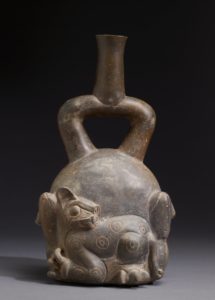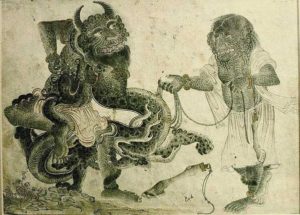
Chavin stirrup-spouted jar from the Walters Art Museum in Baltimore. Image retrieved from Ancient History Encyclopedia http://www.ancient.eu/Chavin_Civilization/
I discovered this intriguing bit of werecat mythology while doing research for the forthcoming, final installment of my Werecat series: The Sim Ru Prophecy. In Chavin culture, a pre-Incan civilization that resided in the region of modern day Peru, potters made clay jars shaped like seated, curled cats. Like ancient Amerindian artwork elsewhere, the cat’s head is exaggerated, almost cartoonish, but the rosette spots are suggestive of the jaguar, which thrived in the region at the time.
According to archeologist Alana Cordy-Collins, a scholar of Peruvian pre-history, these unique jars are also an artifact of an ancient folk belief in human-feline hybrid creatures. In her essay titled: “The jaguar of the backward glance,” published in Nicolas Saunders’ Icons of Power: Feline Symbolism in the Americas, Cordy-Collins states that the jars represent shaman who possess dual souls and have the ability to take the form of jaguars. To the Chavin, a jaguar who is spotted looking over its shoulder is not a big cat but rather a shape-shifting shaman. They preserved that magical secret on their decorative wares.
When I read about that, I was reminded of the anthropomorphic world of Gregory Maguire’s Wicked saga.
“Are you a cat? Or a Cat?”

Jinns by the Ottoman Artist Mehmet Siyah Kalem, retrieved from Islam and Science Fiction http://www.islamscifi.com/jinns-in-islamic-art/
Werecat mythology is not so common in European cultures (to the benefit of werewolves), but there are imaginative werecat storytelling traditions pretty much everywhere else where cats can be found in the world. For example, in the Middle East, there’s the wonderful folk belief in the jinn, which can take the form of the cat, as well as other animals.
If you have dug into my Werecat series, you know that I took a lot of inspiration from ancient Mesoamerican beliefs and most especially the Olmecs. A lot about the Olmecs remains ‘unpacked,’ which makes their history and religion fertile ground for a fantasy author. Archeologists have yet to even understand their language. But their stone monuments, sculptures and glyphs include representations of human/feline hybrids, which has led to the theory that they worshipped a werejaguar god.
That was plenty enough for me as a departure point for creating the mythology behind Werecat. The main character Jacks learns that werecat ‘rearing’ originated from an Olmec king who sacrificed a jaguar cub at the altar of a feline god and then plunged the sacrificial blade into his own heart. The feline god was pleased and allowed the king to return to the material world as a hybrid creature with the power to shift from man to cat.
In the saga’s final installment: The Sim Ru Prophecy, Jacks must decode an ancient codex called The Bastet in order to appeal to an aboriginal feline deity before the codex’s secrets fall into the hands of werecat insurgents, or equally disastrously, humans, who would eliminate Jacks’ kind completely.
As a promotion for the release, you can get started on the series for free. Just sign up for my mailing list at the top of my sidebar, and I’ll send you a copy of The Rearing (Werecat, Book 1).
